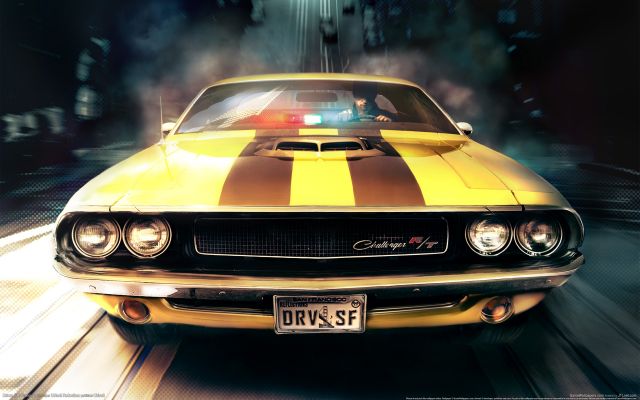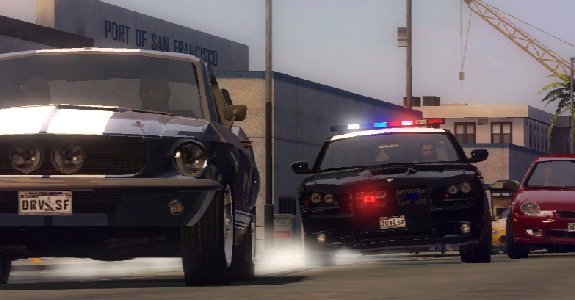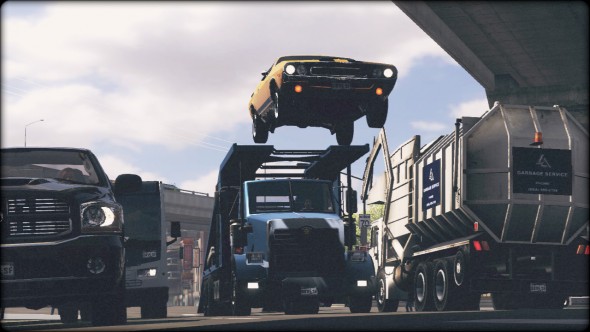

You know those games that sit on your shelf, the ones that you’ll never be able to bring yourself to get rid of? The ones that you keep, just in case you decide to play it once more for nostalgia’s sake? I’ve got a small handful of those. One of them is Driver, the original sandbox vehicular action game from Reflections Interactive and the start of an extremely long-running series.
Driver included a Film Director mode that added hours upon hours of replayability: drive, record, edit film, repeat. Driver 2 added free roam mayhem for two players in split screen, plus the ability to leave your car and steal others, Grand Theft Auto-style. Once again, Film Director mode was a boon for showing off clips to get your friends in the mood for some splitscreen games of car tag. Then came Stuntman (a spiritual successor) and Driv3r. Stuntman eliminated the open world setting in exchange for linear, heavily scripted action sequences...and Driv3r went the opposite direction by incorporating on-foot shooting segments. While both had their positive sides, neither managed to keep the magic of the Driver series at full speed. Because of the games’ niche appeal Reflections had a hard time getting the original audience back after Driv3r.
What may come as a surprise is that Driver: San Francisco is the ninth game in the official series, including two mobile phone games but not including three spiritual successors. And despite the rankles that Driv3r managed to conjure, most of them were decent core games that just had too many bad ideas piled on top. How Reflections managed to get Ubisoft to back yet one more title in what was known as a mediocre lineup is beyond me. Yet they did, and we are the benefactors - in a major way.
I’d like to start off describing my experience with Driver: SF in a single word: homage. This game not only plays well and sounds well...it does so with the flair of classic gearhead films, the funk of the 70’s, the power of classic muscle cars and modern sportsters, and its own ancestor - Driver. The first track that tickled my ears and the main menu were so reminiscent of the original game that the nostalgia was almost overbearing. Then I got a taste of the driving physics, which - while not quite as unsympathetic as the previous games’ - had a slightly higher learning curve than your standard Burnout or Need for Speed.

Car carrier trucks make great ramps for some random mid-chase airtime
Tacked onto the groovy soundtrack and muscle cars are Challenges that can be unlocked and accessed at any one of the garages that you’ve acquired; these Challenges vary from time trials to races to movie-themed scenarios. Secret unlock for going 88 mph in a DeLorean DMC-12? Got it. Loose recreation of the Mustang Mach 1 scene from the original "Gone in 60 Seconds"? Yep. Car chase based on the legendary scene from "Bullitt"? I’m in heaven. Even the parking garage from the Driver training run is here, faithfully reconstructed all the way down to the laundry list of stunts that you once had to perform in order to start the campaign.
A one-minute clip of my time with the Mustang Mach 1
Okay, so it’s obvious that Reflections has a strong nostalgic streak...but what’s new in Driver: SF? Well, for starters: there are more vehicles to drive than in any previous title. It’s downright staggering the number of cars, trucks, and buses that you can unlock - all the way to nonsensical vehicles like front-end loaders and garbage trucks. Of course, your collection is limited to four wheels or more - you won’t see any motorcycles in this city.
Then there’s Shift, the big selling point that’s been pushed in all of the game’s press previews. Shift allows you to float out of your current driver, navigate the city at will, and overtake any other driver you wish. This makes for some really funny in-car conversations and adds to the game the unique aspect of being able to use oncoming traffic against anyone chasing you (or anyone you’re chasing). It seems a bit cheap, and to be honest it does remove a certain chunk of the game’s difficulty. As much as it can be a crutch, though, it’s also a boon for when you want to simply fly across the map to a nearby garage, mission, or side mission. Plus, it’s almost never required - it’s just another gameplay option.
The campaign is set up in a way that you will always have side missions, and they stay available even after you’ve done them once. Usually these serve to unlock specific cars, but they’re also good for building Driver currency, known as Willpower (I don’t want to spoil the plot, so just accept that for what it is). Each story-driven mission has prerequisite missions as well, so you’ll experience a little more variety than the standard “drive here as fast as you can” schtick. If the mission structure has you confused, the easy way to break it down is: yellow icons are required to advanced the story, and blue icons are the extras. Willpower buys garages (there are over a half dozen scattered throughout the bay area), cars, and special abilities. Abilities include an extended boost meter, being able to see nearby collectibles on the radar, and even a cinematic camera that activates when you hit jumps and stunts in Free Roam.
The most criticism I’ve notice for Driver: SF (from other reviewers) is in regards to its plot. I gotta admit - this storyline is as hokey as they come. It’s original - in the most basic sense of the word - and borders on sci-fi...but probably my own biggest complaint is: whereas the origins of the Shift ability could have been a thrilling mystery, it’s explained to the player very early in the campaign. Taking away the “why can I” takes away the “why should I”, and I felt cheated out of what could have been a cool surprise at the end.
Luckily we’re still left with a great driving game, including online multiplayer and couch co-op. The online versus matches connect easily, allowing you to party up with friends or just hop straight into matchmaking. Progression is tracked, and rewards you with the ability to swap your car on the fly and to perform special maneuvers like ramming and boosting. Games of tag and races that include Shift ability for all players can get really hectic...and they’re just plain a lot of fun.
There is also a barebones race mode that disables Shift and offers a refreshing chance to get down to the central focus of the game: driving. In terms of couch co-op: you and one other person can play three splitscreen co-op modes, two of which are scenario-based and simple: one mode challenges both players to stop a racing team by using Shift and driving skills, another mode tasks you both with staying in close proximity to an escaping vehicle by following the trails of its taillights. The third co-op mode is simply splitscreen Free Roam. Once you've chosen a mode you're asked to pick from three available sectors of the map, and then the match starts. Unfortunately you cannot choose your starting vehicle (default cars in Free Roam are a 1970 Challenger for Player 1 and a 1968 Camaro SS for Player 2), but Shift allows you to jump into any other car you want. Some patience may be required if you're looking for a specific style or color.
Although it takes a minute in the menus to find it, you can actually open a Free Roam with a party of up to eight online players. Like Red Dead Redemption and Burnout: Paradise it can serve as a forum for friendly togetherness. You can jump your party into an online competitive game from Free Roam.
Fans of more modern, sport cars will love Driver: San Francisco's selection of vehicles, too
The only drawback that I’ve witnessed to the co-op and multiplayer is that none of your games are recorded for the Film Director - that’s reserved for single player. And since I’m dumping on the Director for a split second, I’d like to also make note that Driver: SF requires a special pass in order to access the online multiplayer and the Film Director - this means that if you don’t buy the game new, you can either purchase the pass later or you can use a 48-hour one time trial period. (Editor's Note: Because of a packaging error, North American copies are all eligible for online pass) It’s a real disappointment to me that such an pillar feature of the series would be subject to anti- used games measures, and my opinion of the game suffers a little because of it. (UPDATE: Apparently Ubisoft found a technical problem within the feature and has disabled it for all regions. Nice!)
Nonetheless, I’m enamored with Driver: San Francisco. This game has managed to turn a two-day rental into a six-day rental, and on top of that I will be purchasing the full game in the near future. I like it that much. My experience with the game has been a pleasurable throwback mixed in with current-gen visuals, flair, and solid versus and co-op support. Online co-op would have clinched a Co-Op Game of the Year nomination from me personally, but as it stands it’s one of my favorite single player games this year...and it has a little smidgeon of really fun co-op to boot.
This review is based on the Xbox 360 version of the game.